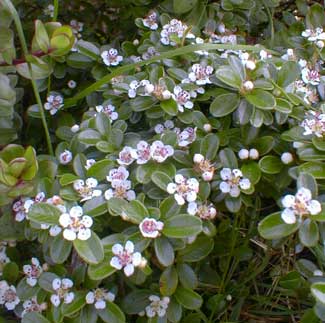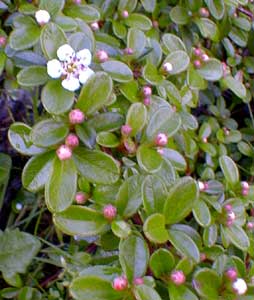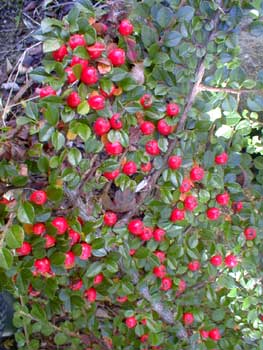
'Coral Beauty'
Bearberry
"Live with me on Earth
among red berries & the bluebirds
And leafy young twigs whispering
Within such little spaces,
between such floors of green, such
figures in the clouds."
-Milton Acorn
(1923-1986)
(1923-1986)
This Chinese Bearberry (Cotoneaster dammeri) grows to a foot or so tall, with the possibility of its semi-prostrate branches stretching six feet wide. Wherever its low-growing branches touch the ground, it roots itself, continuing to colonize rough ground if permitted. It has evergreen or semi-evergreen leaves which turn purple-green in winter.
The name "Bearberry" is regionally given to several low-growing heaths that range into the far north & which feed bears & deer in winter. It is the common name of Arctostaphylos uva-ursi which incorporates references to "bear" into both its genus & species name. Arctostaphylos bearberry shrubs are very similar to the low-growing cotoneasters, but have dangly little bellflowers instead of the hawthorn-flower-like blooms of C. dammeri.
 Other bushes occasionally or regionally known as bearberries include lowbush cranberries (Vaccinium macrocarpon), possum haw (Ilex decidua), alpine bearberry (Arctostaphylos alpina), elderberry (Sambucus nigra), bearberry honeysuckle (Lonicera involucrata), buckthorn (Cascara sagrada), & many others.
Other bushes occasionally or regionally known as bearberries include lowbush cranberries (Vaccinium macrocarpon), possum haw (Ilex decidua), alpine bearberry (Arctostaphylos alpina), elderberry (Sambucus nigra), bearberry honeysuckle (Lonicera involucrata), buckthorn (Cascara sagrada), & many others.Curiously, what the majority of these berries have in common is bitterness of taste, with a mild toxicity that declines after first frost. Pleasanter tasting true berries don't often get called bearberries.
These fruits rarely find their way into human diet, though in reality there's no reason not to harvest them & prepare them with spices & sugar for a tart sauce as pallatable as cranberry.
Cotoneaster berries are not true berries but are pomes, as are apples. These remain green through summer as they develop, then take on their bright color between mid October (as in the third photo) & late September. The ripened coral-colored fruits remain bright on the branches for the entirety of winter & into the following spring, presuming no bird takes a liking to them. Birds ignore the fruit if there is anything better in the vicinity, but may go for them at some point in winter when there is no tastier choice.
 We have several of these forming a loose groundcover out on the street margin, underneath taller shrubs such as the Dawn Viburnum. The limbs produce scads of small white flowers in April & May that can persist to mid-June before beginning their summer-long journey toward red ripe fruit.
We have several of these forming a loose groundcover out on the street margin, underneath taller shrubs such as the Dawn Viburnum. The limbs produce scads of small white flowers in April & May that can persist to mid-June before beginning their summer-long journey toward red ripe fruit.The reddish brown stems can get very scruffy-looking as they spread, but each low shrub is more than amenable to being pruned back to a contained size, becoming more compact in consequence. Over time they can become a more compact groundcover because even fairly widely-spaced planting eventually tangle their limbs into one another's spaces.
Our specific cultivar, 'Coral Beauty,' has a pleasing tendency to remain more compact than the species as a whole & is much more shiny-leafed, whereas the species per se can get spotty & lose the leafy lustre. Furthermore, 'Coral Beauty' produces copious numbers of coral-pink berries, far more berries than on the natural species or other cultivars.
'Coral Beauty' has also been marketed as 'Royal Beauty' or 'Pink Beauty.' It needs regular watering to get established, but is forever after quite drought-hardy. Indeed, it is incredibly hardy in most soils, in sun or part shade, sheltered or in high winds, dry or moist conditions. It does extremely well in poor soils, but the density of fruits will drop back to "normal" fruiting if it lacks a well-draining loamy soil with a yearly pre-spring fertilizing.
We planted four starts in spring 2002 when they were only three or four inches high & six inches wide. A year later, what had begun as small spidery shrublets had very prettily branched out & interlaced with one another. After another year, they had matured into an amazing woody groundcover.